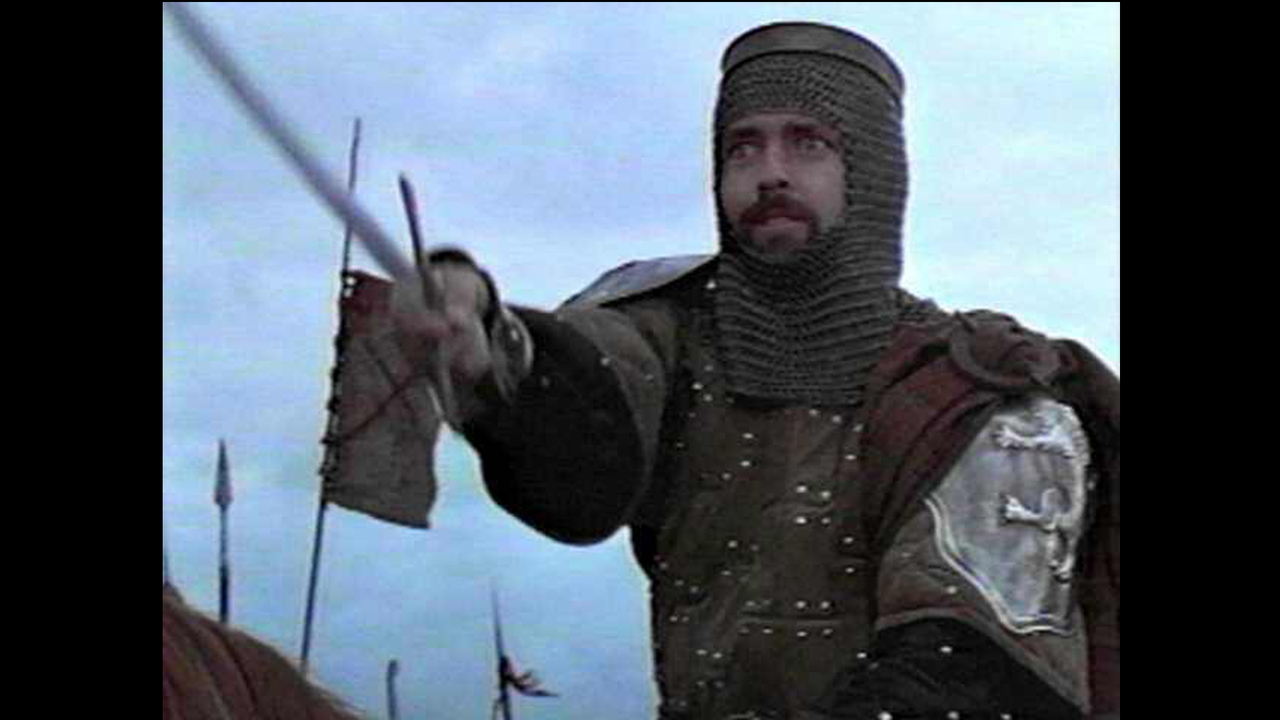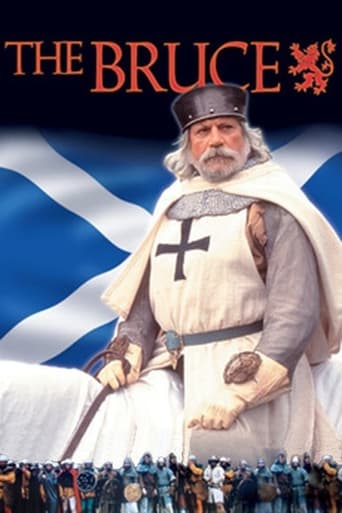



Who payed the critics
Truly Dreadful Film
The movie's neither hopeful in contrived ways, nor hopeless in different contrived ways. Somehow it manages to be wonderful
View MoreThe thing I enjoyed most about the film is the fact that it doesn't shy away from being a super-sized-cliche;
View MoreTo be fair this film was never intended for the big screen, it was made at a time when everyone was buying DVD players and needed to stock up on cheap discs to buff up their collections! Yes it is a bad film, dubious acting, grainy film, and poor battle scenes, but give the film a break, it does have a couple of household names in it, and the history (although slanted and very pro Bruce) is at least far more favourable than its block busting, older sibling 'Braveheart'(which this film is obviously a low budget cash-in of!). Bruce is played competently by Sandy Welch, who portrays the Scottish icon in a sympathetic light, and Pavel Douglas is fantastically over the top as the nasty Red Comyn! Brian Blessed gives a crazy but fulfilling turn as King Edward, and Ollie Reed does good as the bishop! People who are complaining about this film are just negatively comparing it with 'Braveheart', and this is not really fair, the film delivers an account of Robert The Bruce's life, and does so on a very low budget! It is perhaps, too over ambitious, but fitting an epic struggle lasting 25 years into a 110 minute film is reason enough for applause! It would work well as a school film to give kids a history lesson they can expand on later, but its target audience is the couch potato (GUILTY AS CHARGED!), and we don't need $79 million spent on a film, just so long as it tells a good story! Even Wolf from Gladiators gives an OK performance, and if that isn't enough, Robin Hood makes a guest appearance at the end of the film! If its a rainy Wednesday afternoon and the wife is out,and 'Loose Women' is on TV, you will probably be a lot happier giving up an hour and a half on this film than watching the previously mentioned programme!!
View MoreRobert Bruce died in 1329. According to Jean Froissart, when Bruce was dying he asked that Sir James Douglas, as his friend and lieutenant, should carry his heart to the Holy Land and present it at the Holy Sepulchre in Jerusalem as a mark of penance. John Barbour, alternatively, has Bruce ask that his heart should simply be carried in battle against "God's foes" as a token of his unfulfilled ambition to go on crusade. Given that Jerusalem had been in Muslim hands since 1187, this second is perhaps more likely. When Bruce was dead, his heart was cut from his body and placed in a silver and enamelled casket which Sir James placed around his neck. Early in 1330, Douglas set sail from Berwick upon Tweed, accompanied by seven other knights with twenty six squires and gentlemen. The party stopped first at Sluys in Flanders. There it may be that Douglas received confirmation that Alfonso XI of Castile was preparing a campaign against the Muslims of the kingdom of Granada. In anticipation, he had with him a letter of introduction to King Alfonso from Edward III of England, his cousin. Accordingly, the Scots sailed on to Seville, where, according to John Barbour, Sir James and his solemn relic were received by Alfonso with great honour. Douglas and his company joined Alfonso's army, which then was setting out for the frontier of Granada to besiege the castle of Teba. Uthman, the Berber general in command of the Moorish forces, marched to relieve the border stronghold. At some point during the siege, Douglas was killed. Sources and commentators differ as to how. According to Jean Froissart and the Gran Cronica de Alfonso XI, Douglas was killed as a result of making a premature attack on the enemy. The Gran Cronica suggests this might have been during fighting for access to water. Citing John Barbour, some modern commentators believe he died in the decisive Battle of Teba. [16][17] Barbour describes a grand battle in Spain but the setting is vague and the outcome ambiguous. According to the Gran Cronica de Alfonso XI, Uthman, unable to bring the Christians to battle, devised a stratagem in an attempt to force them to abandon the siege. A body of cavalry was sent to make a diversionary attack across the Guadalteba river, luring Alfonso out to fight while Uthman circled round to attack the Christian camp and destroy the besieging army's supplies. Alfonso, however, having received intelligence of Uthman's preparations, kept most of his army back in camp while he sent a contingent to meet the demonstration on the river. It is as part of this force that some commentators assume Douglas and his company joined the battle.[18] When Uthman arrived at the enemy camp he found Alonso's men armed and ready. He abandoned his attack and rode to support the diversionary force on the river where, unable to withstand the Castilian assault, his men were already starting to fall back. Uthman arrived too late to prevent a general rout and the entire Granadan force was driven back in confusion to their camp in the Turon valley, 10 miles to the south. It is in this phase of the battle that some modern commentators have placed Douglas' death, either caught in flank when Uthman's force reached the river or in the ensuing pursuit to the Granadan camp. According to John Barbour's description of Douglas' last battle, when the enemy broke, Sir James and his companions followed hard behind. Having outstripped most of his men in the pursuit, Douglas suddenly found himself far out in front with only a few of his followers around him. As he rode back to rejoin the main body, he saw Sir William St. Clair of Rosslyn surrounded by a body of Moors who, seizing their opportunity, had quickly rallied and counterattacked. With the few knights who were with him, Douglas turned aside to attempt a rescue but, outnumbered twenty to one, the group was overrun. It has become a popular legend that Douglas then took from his neck the silver casket which contained the heart of Bruce and threw it before him among the enemy, saying, "Now pass thou onward as thou wert wont, and Douglas will follow thee or die."[19] This anecdote has its origin in a 16th century addition to Barbour's poem which, however, describes Douglas making the gesture at the beginning of his final battle. It was Sir Walter Scott in Tales of a Grandfather who created the image of Douglas throwing Bruce's heart as his dying act.[20] The Castilian cronica makes no reference to such a catastrophe. It does, however, state that in a fierce skirmish some days prior to the climactic battle, an unnamed 'foreign count' (arguably a reference to Douglas), had died as a result of his own rash behaviour. This is one of only two battle casualties mentioned individually in the Castilian narrative of the campaign. Barbour relates that Sir James and all the men caught with him were killed, including Sir William St. Clair of Rosslyn and Sir Robert Logan of Restalrig. Barbour states that, after this battle, Douglas' body and the casket with Bruce's heart were recovered. His bones, the flesh boiled off them, were taken back to Scotland by Sir William Keith of Galston in Ayrshire (who had missed the battle because of a broken arm), and deposited at St Bride's chapel. The tradition that Sir Simon Locard was a member of the company and also survived, is not found in any of the sources. The heart of Bruce was taken by Moray, the regent, and solemnly interred under the high altar of Melrose Abbey. (see wikipedia for the full article with notes) the heart of the Bruce was added to the Douglas arms sometime following the death of Sir James.
View MoreThe murder of the Red Comyn in Grayfriars Abbey was a long way from one of the most horrendous things ever done in the Scottish War of Independence and fights (and killing) in churches wasn't unusual at all. Not that much later Robert Bruces wife, daughter, two of his sisters were captured during a fight in a church in which people were killed. And comparing it to the massacre of Berwick in which the English slaughtered at least 8000 non-combatants (some, yes, in churches) is ridiculous.That said this is not a well-made movie. It is slightly antidote to the absolutely RIDICULOUS sniveling representation of Robert Bruce in Braveheart. Whatever Bruce was, it wasn't a wuss.Too bad that they didn't do a better job of this because someone should make a really GOOD movie of a war that is so amazing that it sounds like something someone made up going from complete defeat at the Battle of Methven to a secret return from hiding to a long guerrilla war to Bannockburn. This isn't it though. Poorly made and to a large extent poorly written and acted. Too bad!
View MoreThe English are a little too evil, the Scots are a bit tooheroic. The dialogue is overly dramatic at times, and thetransitions between scenes could be smoother.Still, "The Bruce" has the feel of authentic, if unpolished,history ... even if it does play loosely with some importantfacts.Sandy Welch is no Gibson or Branagh, but he makes a stalwartBruce. And Brian Blessed chews the scenery in delightfulvillainy as Edward I.While lacking the budget needed to make the final battle trulyimpressive, they still marshalled an impressive crowd for theEnglish and Scottish armies. It is, according to filmmakers, the"largest filmed reconstruction of medieval battle ever staged inthe British Isles."Allowing for a few failings and shortcomings, the film stilldoes a convincing portrayal.
View More